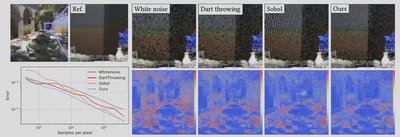Sliced Optimal Transport Sampling
Abstract
In this paper, we introduce a numerical technique to generate sample dis- tributions in arbitrary dimension for improved accuracy of Monte Carlo integration. We point out that optimal transport offers theoretical bounds on Monte Carlo integration error, and that the recently-introduced numerical framework of sliced optimal transport (SOT) allows us to formulate a novel and efficient approach to generating well-distributed high-dimensional pointsets. The resulting sliced optimal transport sampling, solely involving repeated 1D solves, is particularly simple and efficient for the common case of a uniform density over a d-dimensional ball. We also construct a volume- preserving map from a d-ball to a d-cube (generalizing the Shirley-Chiu mapping to arbitrary dimensions) to offer fast SOT sampling over d-cubes. We provide ample numerical evidence of the improvement in Monte Carlo integration accuracy that SOT sampling brings compared to existing QMC techniques, and derive a projective variant for rendering which rivals, and at times outperforms, current sampling strategies using low-discrepancy sequences or optimized samples.

@article{paulin2020,
author = {Loïs Paulin and Nicolas Bonneel and David Coeurjolly and Jean-Claude Iehl and Antoine Webanck and Mathieu Desbrun and Victor Ostromoukhov},
journal = {ACM Transactions on Graphics (Proceedings of SIGGRAPH)},
month = {July},
number = {4},
title = {Sliced Optimal Transport Sampling},
volume = {39},
year = {2020}
}